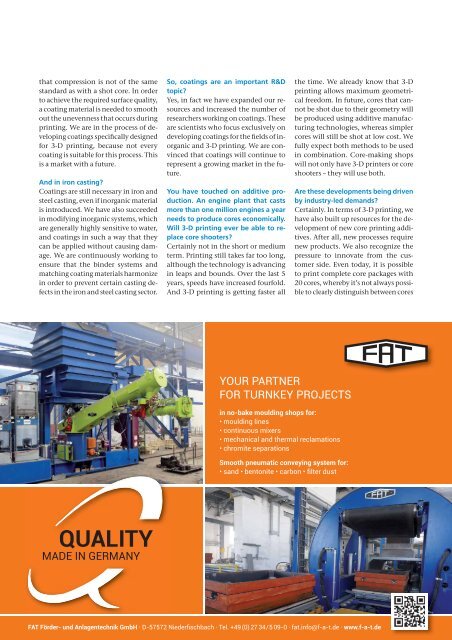CPT International 01/2018
- No tags were found...
Create successful ePaper yourself
Turn your PDF publications into a flip-book with our unique Google optimized e-Paper software.
that compression is not of the same<br />
standard as with a shot core. In order<br />
to achieve the required surface quality,<br />
a coating material is needed to smooth<br />
out the unevenness that occurs during<br />
printing. We are in the process of developing<br />
coatings specifically designed<br />
for 3-D printing, because not every<br />
coating is suitable for this process. This<br />
is a market with a future.<br />
And in iron casting?<br />
Coatings are still necessary in iron and<br />
steel casting, even if inorganic material<br />
is introduced. We have also succeeded<br />
in modifying inorganic systems, which<br />
are generally highly sensitive to water,<br />
and coatings in such a way that they<br />
can be applied without causing damage.<br />
We are continuously working to<br />
ensure that the binder systems and<br />
matching coating materials harmonize<br />
in order to prevent certain casting defects<br />
in the iron and steel casting sector.<br />
So, coatings are an important R&D<br />
topic?<br />
Yes, in fact we have expanded our resources<br />
and increased the number of<br />
researchers working on coatings. These<br />
are scientists who focus exclusively on<br />
developing coatings for the fields of inorganic<br />
and 3-D printing. We are convinced<br />
that coatings will continue to<br />
represent a growing market in the future.<br />
You have touched on additive production.<br />
An engine plant that casts<br />
more than one million engines a year<br />
needs to produce cores economically.<br />
Will 3-D printing ever be able to replace<br />
core shooters?<br />
Certainly not in the short or medium<br />
term. Printing still takes far too long,<br />
although the technology is advancing<br />
in leaps and bounds. Over the last 5<br />
years, speeds have increased fourfold.<br />
And 3-D printing is getting faster all<br />
the time. We already know that 3-D<br />
printing allows maximum geometrical<br />
freedom. In future, cores that cannot<br />
be shot due to their geometry will<br />
be produced using additive manufacturing<br />
technologies, whereas simpler<br />
cores will still be shot at low cost. We<br />
fully expect both methods to be used<br />
in combination. Core-making shops<br />
will not only have 3-D printers or core<br />
shooters – they will use both.<br />
Are these developments being driven<br />
by industry-led demands?<br />
Certainly. In terms of 3-D printing, we<br />
have also built up resources for the development<br />
of new core printing additives.<br />
After all, new processes require<br />
new products. We also recognize the<br />
pressure to innovate from the customer<br />
side. Even today, it is possible<br />
to print complete core packages with<br />
20 cores, whereby it’s not always possible<br />
to clearly distinguish between cores<br />
YOUR PARTNER<br />
FOR TURNKEY PROJECTS<br />
in no-bake moulding shops for:<br />
• moulding lines<br />
• continuous mixers<br />
• mechanical and thermal reclamations<br />
• chromite separations<br />
Smooth pneumatic conveying system for:<br />
<br />
QUALITY<br />
MADE IN GERMANY<br />
Casting Plant & Technology 1 / 2<strong>01</strong>8 9<br />
FAT Förder- und Anlagentechnik GmbH www.f-a-t.de


















